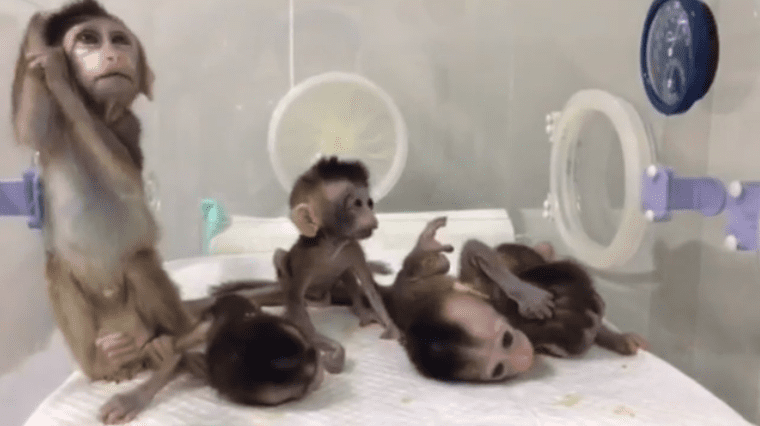Chinese Scientists Clone Five Monkeys and Deliberately Give Them Mental Health Conditions Using Gene Editing
Five cloned monkeys have been born with a host of genetic mental health
conditions in a controversial experiment in China. The
monkeys - all clones of one primate - have been specially bred to create a
'diseased' population of animals to use in laboratory tests. All five have
the same DNA altered, which has resulted in symptoms similar to the human
conditions of anxiety, depression and schizophrenia.




The quintet were born at the Institute of Neuroscience (ION) of the
Chinese Academy of Sciences (CAS) in Shanghai. Researchers used the same
technique as was used last year to produce Zhong Zhong and Hua Hua – the first
ever two cloned monkeys - and Dolly the sheep, famously cloned in the late 90s
in Scotland.
The animals will be destined for a life in a laboratory and the
scientists claim the gene-edited primates will be used to test groundbreaking
new treatments for diseases ranging from brain disorders to cancers. But
this latest move will inevitably raise ethical questions about the future of
human cloning - and how close modern science is moving towards gene-edited
clones.
China has also been rocked by controversy after scientist He Jiankui
claimed to have created the world's first genetically edited babies.
State officials say he acted illegally in pursuit of fame and fortune. Scientists
hope that by repeating this process they can create one animal that exhibits
the right symptoms and then use this as the future blueprint for all
clones.

Cells from a donor monkey were used to create the clones. A process known
as somatic cell nuclear transfer (SCNT) was used to create the animals and it
is the same procedure used to generate Zhong Zhong and Hua Hua, the first
two cloned monkeys, and Dolly the sheep back in 1996. Chinese scientists say
the advance, reported online by the journal National Science Review, said
the cloned quintet showed signs of a wide-range of symptoms associated with the
loss of BMAL1.
The donor animals had this section of DNA deactivated via the famed
gene-editing technique Crispr-Cas9. This powerful tool allows scientists
to manipulate genetic material and the changes are permanent and passed on down
the generations. It is also the technique allegedly used by Dr
He Jiankui in China to create the first genetically modified human babies.
A pair of twins were created to be resistant to HIV by the now ostracised and
disgraced academic. He received huge backlash from his work due to the heinous
ethical violations.

Crispr and cloning is, however, permitted under international guidelines
for animals. Study senior author and investigator Dr Hung-Chun Chang said:
“Disorder of circadian rhythm could lead to many human diseases, including sleep disorders, diabetic mellitus, cancer, and neurodegenerative diseases. Our monkeys thus could be used to study the disease pathogenesis as well as therapeutic treatments.”
To create the monkey clones, Chinese researchers removed the nucleus from
a monkey egg cell. This was then replace with the nucleus from another cell in
its body - from a fibroblast, a cell that creates collagen. A fibroblast is a
somatic cell, meaning it comes from the body not the reproductive organs, and
this provided the egg with the full compliment of chromosomes.
Egg and sperm cells undergo a process called meiosis where they half
their chromosomes and rely on fertilisation to occur for the full set to be
completed. Once the fibroblast nucleus was implanted in the egg cell, the
embryo was cultivated and differentiates until it forms a complete organism. This
is an identical copy of the original animal, flaws and all.
The embryo is implanted into the womb of a surrogate monkey that eventually
give birth to the clones. Zhong Zhong and Hua Hua hit headlines last year when
they were born using the same method with cells from an aborted foetus.
Dr Qiang Sun, director of ION's Non-human Primate Research Facility,
said:
“Our approach is to perform gene-editing in fertilised embryos to first generate a group of gene-edited monkeys, and then select one monkey that exhibits correct gene editing and most severe disease phenotypes as the donor monkey for cloning. We believe that this approach of cloning gene-edited monkeys could be used to generate a variety of monkey models for gene-based diseases, including many brain diseases, as well as immune and metabolic disorders and cancer.”
The researchers plan to continue improving the technique to increase the
efficiency of cloning. They are expecting more macaque clones carrying
disease-causing gene mutations to be generated in the coming years. But they
said the Institute of Neuroscience follows strict international guidelines for
animal research.
Co-author Professor Mu-ming Poo, who directs the Institute of
Neuroscience and helped to supervise the project, said:
“This work required coordinated efforts of many laboratories, and serves as a clear example of the efficient team work that is highly emphasised by CAS. This line of research will help to reduce the amount of macaque monkeys currently used in biomedical research around the world.
Without the interference of genetic background, a much smaller number of cloned monkeys carrying disease phenotypes may be sufficient for pre-clinical tests of the efficacy of therapeutics.”
Since Dolly was cloned in Scotland back in 1996, more than 20 species of
mammals have been cloned around the world - including cattle, cats, dogs,
horses and rats.
Comments
Post a Comment